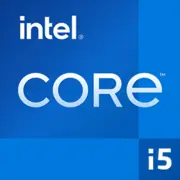Intel Core i5-11400

Intel Core i5-11400 in 2025: Is it worth getting a processor from the previous generation?
An up-to-date review for budget builds and upgrades
Key Features: Architecture and Performance
The Intel Core i5-11400 processor, released in 2021, remains a popular choice for budget PCs. Despite its age, its specifications still look balanced even in 2025:
- Architecture: Rocket Lake-S (hybrid structure with PCIe 4.0 support).
- Manufacturing Process: 14 nm (Intel has already moved to 7 nm in new generations, but this is not critical for basic tasks).
- Cores and Threads: 6 cores, 12 threads. Base frequency — 2.6 GHz, turbo mode up to 4.4 GHz.
- Cache: 12 MB L3.
- TDP: 65 W (energy efficiency is one of its key advantages).
- Graphics: Intel UHD Graphics 730 (suitable for office tasks and less demanding games).
Performance:
- In Geekbench 6 (2025), the processor scores 1915 points in single-core and 7552 points in multi-core tests. This performance level is sufficient for comfortable work in Photoshop, 3D modeling, and gaming at medium settings (e.g., Cyberpunk 2077 offers stable 50-60 FPS at Full HD when using a graphics card like the RTX 3060).
Key Features:
- Support for PCIe 4.0 (but only for SSDs and graphics cards if the motherboard has the corresponding chipset).
- Technologies like Intel Quick Sync Video (video rendering acceleration) and Deep Learning Boost (AI task optimization).
Compatible Motherboards: Sockets and Chipsets
The processor uses the LGA 1200 socket, which limits motherboard options to models from 2020-2021. In 2025, new LGA 1200 motherboards are no longer produced, but you can still find:
- Budget Options: Motherboards with H510 chipset (from $80) — for example, ASRock H510M-HDV. Suitable for office PCs, but they do not support memory overclocking beyond 2666 MHz.
- Optimal Choice: B560 (from $100) — MSI B560M PRO-VDH. Here you get PCIe 4.0, RAM overclocking up to 3200 MHz, and improved power supply for the processor.
- For Enthusiasts: Z590 (from $150) — Gigabyte Z590 AORUS ELITE. Overclocking support, 2 PCIe 4.0 slots, and an 8-layer PCB for stability.
Tip: Avoid H410 chipsets — they do not support PCIe 4.0 and XMP profiles for memory.
Supported Memory: DDR4 as the Standard
The i5-11400 only works with DDR4 (maximum 3200 MHz in XMP mode). By 2025, DDR4 has already been surpassed by DDR5 in bandwidth but remains cheaper:
- 16 GB DDR4-3200 — starts at $45 (for example, Kingston Fury Beast).
- For gaming, 16 GB is sufficient; for video editing, 32 GB is recommended.
Important: Inexpensive motherboards on H510 limit memory frequency to 2666 MHz. If you want to get the most out of your RAM, choose B560/Z590.
Power Supply: Power Calculation
With a TDP of 65 W, the processor does not require a powerful PSU, but when connecting a discrete graphics card, it's important to consider the overall power consumption:
- Integrated Graphics: PSU of 300-400 W (for example, be quiet! Pure Power 11 400W).
- With a graphics card like RTX 4060: PSU of 500-600 W (Corsair CX650M, $70).
- Tip: Don’t skimp on the power supply. Cheap models (like Apevia) may operate unstably under load.
Pros and Cons of i5-11400 in 2025
Advantages:
1. Price: New processors are rarely available, but leftovers can be found for $150-170.
2. Energy Efficiency: Even under load, consumes less than 100 W.
3. Integrated Graphics: Useful if your graphics card fails.
Disadvantages:
1. Outdated Manufacturing Process: 14 nm vs 7-5 nm found in Ryzen 7000/8000.
2. No Support for DDR5 and PCIe 5.0.
3. Limited Upgrade Potential: LGA 1200 socket is incompatible with newer Intel generations.
Use Cases: Where the Processor is Relevant
1. Gaming: Paired with RTX 3060/4060, it delivers 60+ FPS in Full HD (example: Elden Ring on high settings).
2. Office and Multimedia: Streaming 4K, working with documents, Zoom conferences.
3. Rendering: In Blender or Premiere Pro, rendering a medium-difficulty project may take 15-20% longer than on a Ryzen 5 7600, but that’s acceptable for hobby projects.
Real Experience: A user on Reddit built a PC with an i5-11400 and RX 6600 for streaming — the system runs OBS + game without lags.
Comparison with Competitors
1. AMD Ryzen 5 5600X (6/12, 3.7-4.6 GHz):
- Pros: 7 nm, PCIe 4.0 available on all chipsets.
- Cons: More expensive (from $180), no integrated graphics.
- Conclusion: The choice depends on pricing — if the difference is under $30, Ryzen is the better option.
2. Intel Core i5-12400F (Alder Lake, 2022):
- Pros: 10 nm, DDR5, 15-20% higher performance.
- Cons: No new units available for purchase.
Assembly Tips
1. Cooling: The boxed cooler is adequate, but for quieter operation, consider the DeepCool AK400 ($30).
2. Motherboard: If you need PCIe 4.0, go for B560/Z590.
3. BIOS Update: Older motherboards may require an update for proper operation.
Final Conclusion: Who is the i5-11400 Suitable For?
This processor is worth considering if:
- Your budget is up to $500 for the whole build.
- You need a PC for work, study, or gaming without ultra settings.
- You are upgrading an old system (for example, from i3-10100).
Alternative: If you can spend $50-100 more, look for a used Ryzen 5 7600 or a new Intel Core i3-14100 (newer but has only 4 cores).
In 2025, the i5-11400 is a rational choice for those who value the balance between price and performance but are not chasing trends.
Basic
CPU Specifications
Memory Specifications
GPU Specifications
Benchmarks
Compared to Other CPU
Share in social media
Or Link To Us
<a href="https://cputronic.com/en/cpu/intel-core-i5-11400" target="_blank">Intel Core i5-11400</a>